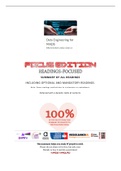Summary
Readings Summary for Data Engineering for MADS (Mandatory & Optional Papers + Book Chapters)
- Course
- Institution
- Book
The best summary of ALL READINGS for Data Engineering for MADS (EBM213A05). Includes both mandatory and optional papers and book chapters. Enhanced with a dynamic table of contents and meticulous organization for readability and easy studying. 100% of profit from this summary is donated to local Gr...
[Show more]




